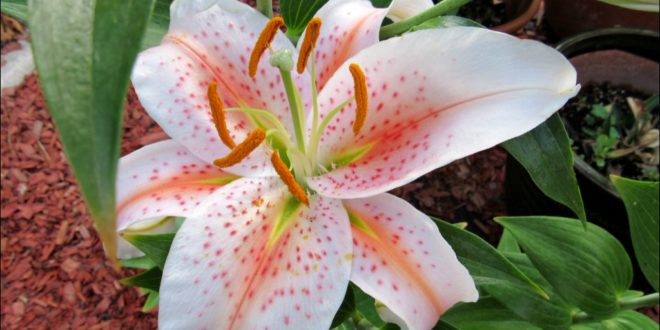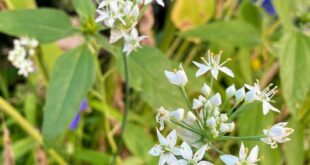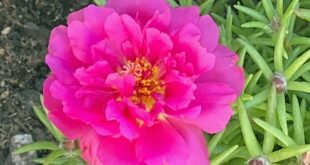June is always the most intense month in our Sunnyvale garden. All at once the berries and stone fruits (apricots, plums, nectarines) are ripe. Meanwhile the citrus (lemons and limes) still are available. The tomato plants, all 45 of them, are producing fruit with a few ripe ones. My chile plants (8 varieties) are productng fruit. The early season ones are harvestable now. The yard is filled with flowers. The flowers listed this month are just the new ones.
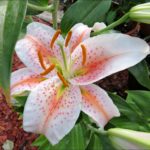 Every year we try a different cultivar of lily in our Sunnyvale garden. This year was the “Salmon Star”. It didn’t disappoint with its large flowers, spotted pink with gold and white edges. Asiatic and Oriental lilies are examples of true lilies (from the genus Lilium and having plump scaly bulbs). Daylilies, canna lilies, and peace lilies, despite having the word “lily” in their names, are not true lilies.) In medium size pots, they grow 28-36 inches tall. This variety blooms mid summer. They can take full sun but in temps above 100 degrees, the petals get scorched.
Every year we try a different cultivar of lily in our Sunnyvale garden. This year was the “Salmon Star”. It didn’t disappoint with its large flowers, spotted pink with gold and white edges. Asiatic and Oriental lilies are examples of true lilies (from the genus Lilium and having plump scaly bulbs). Daylilies, canna lilies, and peace lilies, despite having the word “lily” in their names, are not true lilies.) In medium size pots, they grow 28-36 inches tall. This variety blooms mid summer. They can take full sun but in temps above 100 degrees, the petals get scorched.
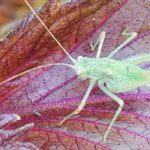 Sometimes vegetarians are not welcome: I found a diner on our Red Shiso plant. Perilla frutescens, or shiso, is an easy to grow herb in the mint family that is usually planted in the spring and harvested in the summer and fall, unless you live in a climate like Southern California, where it can be grown year round. The red shiso is often described as having an anise flavor, whereas the green variety is said to be spicier and more like cinnamon. Leaves are often wrapped around sushi or served with “sashimi” as a garnish. They also are added to soups, tempura or dried and sprinkled over rice. Japanese chefs add red perilla to tofu or bean curd dishes or use it wrapped around pieces of meat. Leaves can also be boiled into a beverage similar to a mint julep.
Sometimes vegetarians are not welcome: I found a diner on our Red Shiso plant. Perilla frutescens, or shiso, is an easy to grow herb in the mint family that is usually planted in the spring and harvested in the summer and fall, unless you live in a climate like Southern California, where it can be grown year round. The red shiso is often described as having an anise flavor, whereas the green variety is said to be spicier and more like cinnamon. Leaves are often wrapped around sushi or served with “sashimi” as a garnish. They also are added to soups, tempura or dried and sprinkled over rice. Japanese chefs add red perilla to tofu or bean curd dishes or use it wrapped around pieces of meat. Leaves can also be boiled into a beverage similar to a mint julep.
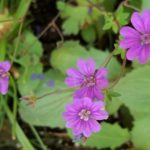 Geranium pyrenaicum ‘Bill Wallis’ has deep purple-blue blooms that present a cloud of color, 15” tall x 20” across from Spring thru Fall. Drought-tolerant, reliably perennial, it happily self-sows to fill in bare spots with its ever-present color. When the flowers are spent (after months), cut back to 1”, side dress with compost & it’ll burst right back into bloom. BEST in rich soil & half day sun, but not required. Also heat tolerant. The individual flower petals are heart shaped & very cute in a pressed-flower context. Great in containers & perfect under yellow roses!
Geranium pyrenaicum ‘Bill Wallis’ has deep purple-blue blooms that present a cloud of color, 15” tall x 20” across from Spring thru Fall. Drought-tolerant, reliably perennial, it happily self-sows to fill in bare spots with its ever-present color. When the flowers are spent (after months), cut back to 1”, side dress with compost & it’ll burst right back into bloom. BEST in rich soil & half day sun, but not required. Also heat tolerant. The individual flower petals are heart shaped & very cute in a pressed-flower context. Great in containers & perfect under yellow roses!
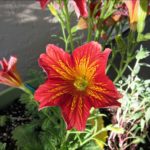 Salpiglossis: a name that just rolls off the tongue. Which it should since the genus name comes from the Greek words sappinx meaning trumpet and glossa meaning tongue with reference to the elongated trupet-shaped flowers. It is a spectacular flower. I don’t know how I missed this flower over the years. Funnel-shaped, wide-throated, 5-lobed flowers (to 2” wide) in clusters bloom from late spring to early summer, with continued bloom throughout summer usually occurring only in cool summer areas. Flower colors typically include shades of red, orange, yellow, bronze, violet or purple, usually with marbling or contrasting veins.
Salpiglossis: a name that just rolls off the tongue. Which it should since the genus name comes from the Greek words sappinx meaning trumpet and glossa meaning tongue with reference to the elongated trupet-shaped flowers. It is a spectacular flower. I don’t know how I missed this flower over the years. Funnel-shaped, wide-throated, 5-lobed flowers (to 2” wide) in clusters bloom from late spring to early summer, with continued bloom throughout summer usually occurring only in cool summer areas. Flower colors typically include shades of red, orange, yellow, bronze, violet or purple, usually with marbling or contrasting veins.
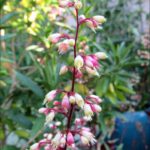 Coral Bells (genus Heuchera) are a great foliage plant. The leaves are often large and heart-shaped or rounded, and many are variegated or ruffled. Starting in late spring, graceful, bell-shaped flower clusters open, carried on spikes that grow about two feet tall. Because these North American natives are evergreen (USDA zones 4 – 9), they bring year-round interest to the garden. We have ours growing in a large container with Lion’s Tail, Bacopa, Society Garlic, and Globe Amaranth.coral-bell-leaves. Coral bells can be easily grown in the garden. These plants do better in shade or filtered sun.
Coral Bells (genus Heuchera) are a great foliage plant. The leaves are often large and heart-shaped or rounded, and many are variegated or ruffled. Starting in late spring, graceful, bell-shaped flower clusters open, carried on spikes that grow about two feet tall. Because these North American natives are evergreen (USDA zones 4 – 9), they bring year-round interest to the garden. We have ours growing in a large container with Lion’s Tail, Bacopa, Society Garlic, and Globe Amaranth.coral-bell-leaves. Coral bells can be easily grown in the garden. These plants do better in shade or filtered sun.
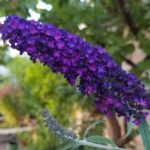 We have grown Buddleia in containers in our Sunnyvale garden for ten years.The purple flower panicle when it starts blooming in June is very beautiful. Unfortunately for Buddleia, as the year progresses, other flowers and fruits distract us.
We have grown Buddleia in containers in our Sunnyvale garden for ten years.The purple flower panicle when it starts blooming in June is very beautiful. Unfortunately for Buddleia, as the year progresses, other flowers and fruits distract us.
Buddleja, or Buddleia, aka Butterfly Bush, Summer Lilac, Orange-eye Butterfly Bush, Buddleja fallowiana ‘Lochinch’, is a genus comprising over 140 species of flowering plants endemic to Asia, Africa, and the Americas. The generic name bestowed by Linnaeus posthumously honored the Reverend Adam Buddle (1662–1715), an English botanist.
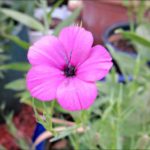 Pink German Catchfly (Viscaria oculata) is a pretty annual. Each 1-inch flower has five petals around a dark eye. Ours started blooming May 20. They bloom for about 4 months. The common name “catchfly” is used because the stems secrete a sticky liquid that traps small insects. The flower has been in British gardens since the 1840s. No flower seed is easier to grow than Viscaria seeds. First planted: 2017. Nursery: Annie’s Annual. Nursery: Yamagami of Cupertino. First planted: 2017. Nursery: Annie’s Annual. Nursery: Yamagami of Cupertino. First planted: 2017. Nursery: Annie’s Annual. Nursery: Yamagami of Cupertino.
Pink German Catchfly (Viscaria oculata) is a pretty annual. Each 1-inch flower has five petals around a dark eye. Ours started blooming May 20. They bloom for about 4 months. The common name “catchfly” is used because the stems secrete a sticky liquid that traps small insects. The flower has been in British gardens since the 1840s. No flower seed is easier to grow than Viscaria seeds. First planted: 2017. Nursery: Annie’s Annual. Nursery: Yamagami of Cupertino. First planted: 2017. Nursery: Annie’s Annual. Nursery: Yamagami of Cupertino. First planted: 2017. Nursery: Annie’s Annual. Nursery: Yamagami of Cupertino.
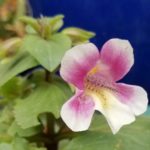 Mega Monkey Flower (Mimulus naiandinus). A larger bloomed perennial Monkey Flower of pink with a white tongue that fades into a yellow mottled throat perched atop slender dark stems and green foliage. It prefers wet soils but responds well to container planting as well (I grow mine in a wide shallow bowl with tiger eye violas, bill wallis geranium, and sea-thrift. Large blooms appear Spring thru Summer. Twice the size of the original Chilean species. Cut back anytime to refresh growth and bloom. Deciduous but reliably returns each Spring. Rich soil. Self-sows!
Mega Monkey Flower (Mimulus naiandinus). A larger bloomed perennial Monkey Flower of pink with a white tongue that fades into a yellow mottled throat perched atop slender dark stems and green foliage. It prefers wet soils but responds well to container planting as well (I grow mine in a wide shallow bowl with tiger eye violas, bill wallis geranium, and sea-thrift. Large blooms appear Spring thru Summer. Twice the size of the original Chilean species. Cut back anytime to refresh growth and bloom. Deciduous but reliably returns each Spring. Rich soil. Self-sows!
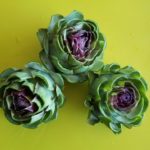 It’s June 1 and these are the last of our artichokes. We had two plants: a Roma and a Violetta (instead of the usual Green Globe). I harvested the first flowerhead of each plant in early May. These are the secondary heads. This has been an experiment: I tried a few times before. Each plant was in a medium container (10 gallons). They required daily watering and twice-weekly fertilizer. It is a lot of work for 6 artichokes! The internet suggests that boil/steam is slightly better than microwaving. Marie has used the microwave method for 30 years and it tastes the same. This recipe is a version from Bobby Flay.
It’s June 1 and these are the last of our artichokes. We had two plants: a Roma and a Violetta (instead of the usual Green Globe). I harvested the first flowerhead of each plant in early May. These are the secondary heads. This has been an experiment: I tried a few times before. Each plant was in a medium container (10 gallons). They required daily watering and twice-weekly fertilizer. It is a lot of work for 6 artichokes! The internet suggests that boil/steam is slightly better than microwaving. Marie has used the microwave method for 30 years and it tastes the same. This recipe is a version from Bobby Flay.
 Every summer when the fruit is ripe, we make galettes. A galette is a free-form pie shell that is not-precooked before adding the fillings. It can be sweet from fruit or savory like a pizza. Our first galette for 2017 has 4 cups of blackberries and marionberries.
Every summer when the fruit is ripe, we make galettes. A galette is a free-form pie shell that is not-precooked before adding the fillings. It can be sweet from fruit or savory like a pizza. Our first galette for 2017 has 4 cups of blackberries and marionberries.
Pie shell Ingredients: 1 1/3 cup all-purpose flour; 1/2 teaspoon salt; 1 stick of unsalted butter, cut into cubes; 1/4 cup ice water
Pie Filling Ingredients: 4 cups blackberries; 2 Tablespoons lemon juice; 1/4 cup sugar; 3 Tablespoons flour
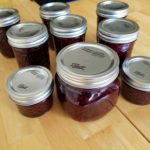 You can only eat so many blackberries and marionberries in two weeks. Since we have over 30 linear feet of berries, that is a lot of berries! We have been eating them fresh. We have been making galettes. So now we are making this delicious jam. Jams and jellies only became common with the introduction of cheap cane sugar . It is the sugar that provides the preservation. Note this recipe makes about 8 jars
You can only eat so many blackberries and marionberries in two weeks. Since we have over 30 linear feet of berries, that is a lot of berries! We have been eating them fresh. We have been making galettes. So now we are making this delicious jam. Jams and jellies only became common with the introduction of cheap cane sugar . It is the sugar that provides the preservation. Note this recipe makes about 8 jars
Ingredients: Marionberries and/or blackberries (about two and one-half pounds); 6 1/2 cups sugar; Ball Liquid Fruit Pectin pouch
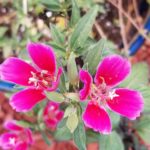 Billowing over the front of a bed like a cloud of butterflies held on shiny red stems, California native “Pink Ribbons” fascinates everyone with its surprisingly silky, 1.25” pinwheel profuse blooms. Choice for mixed plantings, containers and even hanging baskets, where they’ll attract all manner of butterflies and bees. Mix it in with other spilly CA natives like “Baby-Blue-Eyes”. A wonderful annual for part shade (perfect under azaleas) and a nice change from Impatiens. Average to rich soil (no clay). To 10” tall x 20” wide. Self-sows. Drought-tolerant.
Billowing over the front of a bed like a cloud of butterflies held on shiny red stems, California native “Pink Ribbons” fascinates everyone with its surprisingly silky, 1.25” pinwheel profuse blooms. Choice for mixed plantings, containers and even hanging baskets, where they’ll attract all manner of butterflies and bees. Mix it in with other spilly CA natives like “Baby-Blue-Eyes”. A wonderful annual for part shade (perfect under azaleas) and a nice change from Impatiens. Average to rich soil (no clay). To 10” tall x 20” wide. Self-sows. Drought-tolerant.
 We have had fennel in our Sunnyvale garden since 2001. It’s original spot is in a side-strip under an apricot tree. This year it appeared in our jumbo pot with the mission fig tree. It reseeds easily. Any place you don’t want it, just pull it up. The feathery leaves remind me of dill and it has a nice scent. The small yellow flowers appear on the ends of each umbrella.
We have had fennel in our Sunnyvale garden since 2001. It’s original spot is in a side-strip under an apricot tree. This year it appeared in our jumbo pot with the mission fig tree. It reseeds easily. Any place you don’t want it, just pull it up. The feathery leaves remind me of dill and it has a nice scent. The small yellow flowers appear on the ends of each umbrella.
If you want to eat the Fennel bulb then make sure you get the Florence Fennel. Fennel is a flowering plant species in the celery family Apiaceae or Umbelliferae. It is the sole species in the genus Foeniculum. It is a hardy, perennial herb with yellow flowers and feathery leaves.
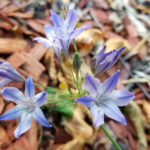 Brodiaea laxa, aka triplet lily, grassnut lily, or wild hyacinth. This perennial bulb is a native wildflower to California, growing wild in evergreen woodlands. Locally, it is found in places like Edgewood Preserve on the San Mateo County peninsula and Almaden Quicksilver County Park. Grass-like leaves appear first, followed by clusters of light blue blossoms reaching 15 to 20 inches tall and appearing in the late spring. Triplet lilies grow best in U.S. Department of Agriculture plant hardiness zones 7 through 10. Fall is the best time to plant these bulbs in flower beds and rock gardens. I grow it in my former fire-pit.
Brodiaea laxa, aka triplet lily, grassnut lily, or wild hyacinth. This perennial bulb is a native wildflower to California, growing wild in evergreen woodlands. Locally, it is found in places like Edgewood Preserve on the San Mateo County peninsula and Almaden Quicksilver County Park. Grass-like leaves appear first, followed by clusters of light blue blossoms reaching 15 to 20 inches tall and appearing in the late spring. Triplet lilies grow best in U.S. Department of Agriculture plant hardiness zones 7 through 10. Fall is the best time to plant these bulbs in flower beds and rock gardens. I grow it in my former fire-pit.
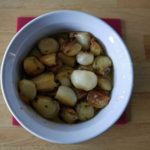 I love growing garlic and elephant garlic in my Sunnyvale garden. They are easy to plant; hardy to drought and frost; they produce beautiful flowers (if you let them) and they produce garlic. The harvest process is not difficult but it takes some time: You stop watering the garlic for a few weeks; pull up the plant; let it dry for a few more weeks (preferably in a cool dark location). In our household, there is trouble with this process. A dozen head of Garlic drying in the kitchen smells very potent (or stinks depending on who is telling the story). Ditto on storing it in a spare bedroom. Storing it in a small tool-room was a no-go: It adjoined the craft studio and the smell was infiltrating the fabric. The current solution is outside in a box that stores the patio cushions in the wet season.
I love growing garlic and elephant garlic in my Sunnyvale garden. They are easy to plant; hardy to drought and frost; they produce beautiful flowers (if you let them) and they produce garlic. The harvest process is not difficult but it takes some time: You stop watering the garlic for a few weeks; pull up the plant; let it dry for a few more weeks (preferably in a cool dark location). In our household, there is trouble with this process. A dozen head of Garlic drying in the kitchen smells very potent (or stinks depending on who is telling the story). Ditto on storing it in a spare bedroom. Storing it in a small tool-room was a no-go: It adjoined the craft studio and the smell was infiltrating the fabric. The current solution is outside in a box that stores the patio cushions in the wet season.
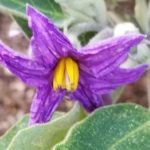 Fairy Tale eggplants are less seedy than their large Italian counterparts and lack their bitterness. If you are like me, you need a good recipe for these baby heirloom eggplants during the summer months. Throw these sweet little japanese eggplant on the grill alongside steak or lamb. With purple and white stripes and a miniature form, they are completely irresistible. Attractive, 2-4″ long by 3/4-1 1/4″ diameter, fruits are borne abundantly on compact 18-24″ plants. I am growing mine in a medium-size pot with red shiso and a chile plant.
Fairy Tale eggplants are less seedy than their large Italian counterparts and lack their bitterness. If you are like me, you need a good recipe for these baby heirloom eggplants during the summer months. Throw these sweet little japanese eggplant on the grill alongside steak or lamb. With purple and white stripes and a miniature form, they are completely irresistible. Attractive, 2-4″ long by 3/4-1 1/4″ diameter, fruits are borne abundantly on compact 18-24″ plants. I am growing mine in a medium-size pot with red shiso and a chile plant.
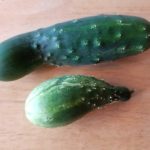 I am always challenged growing cucumbers. I do not have the horizontal landscape to let them sprawl; so either I get a bush variety or train a sprawler to go up a trellis. Also the premier sunny locations are allocated for the tomatoes. This variety is favorite of gardeners for high yields of short cukes with solid flesh. Cucumbers are thin-skinned, straight with full ends, and a nice green color. Vines bear continuously. Flesh is crisp and very receptive to pickling spices. Great for any pickling recipe, whether sweets or dills. May be harvested at sizes from 3 to 7 inches, depending on your pickling needs.
I am always challenged growing cucumbers. I do not have the horizontal landscape to let them sprawl; so either I get a bush variety or train a sprawler to go up a trellis. Also the premier sunny locations are allocated for the tomatoes. This variety is favorite of gardeners for high yields of short cukes with solid flesh. Cucumbers are thin-skinned, straight with full ends, and a nice green color. Vines bear continuously. Flesh is crisp and very receptive to pickling spices. Great for any pickling recipe, whether sweets or dills. May be harvested at sizes from 3 to 7 inches, depending on your pickling needs.
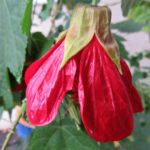 Chinese lantern, Chinese bell flower and collectively as abutilon, are evergreen shrubs enjoyed for their maple-like leaves and bell-like, pendulous flowers. Hardiness varies by species, but most survive up to U.S. Department of Agriculture plant hardiness zone 8 or 9, and some cultivars are grown as container specimens or houseplants in cooler regions. Abutilons have a tendency to become leggy and benefit form regular pruning to maintain compactness. Abutilons produce flowers on the current season’s growth, so prune in late winter or early spring.
Chinese lantern, Chinese bell flower and collectively as abutilon, are evergreen shrubs enjoyed for their maple-like leaves and bell-like, pendulous flowers. Hardiness varies by species, but most survive up to U.S. Department of Agriculture plant hardiness zone 8 or 9, and some cultivars are grown as container specimens or houseplants in cooler regions. Abutilons have a tendency to become leggy and benefit form regular pruning to maintain compactness. Abutilons produce flowers on the current season’s growth, so prune in late winter or early spring.
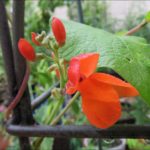 Scarlet runner beans have large, beautiful, vigorous vines that grow over 10 feet tall. Flowers are very ornamental, in clusters of the brightest scarlet. Good for snap, shell or dry beans. The huge seeds are very colorful, violet-purple mottled in black. These beans like fairly cool weather. I planted mine late this spring so I am expecting only flowers. Used by native Americans, large, beautiful, vigorous vines grow over 10’. Flowers are very ornamental, in clusters of the brightest scarlet. Good for snap, shell or dry beans. The huge seeds are very colorful, violet-purple mottled in black. These beans like fairly cool weather.
Scarlet runner beans have large, beautiful, vigorous vines that grow over 10 feet tall. Flowers are very ornamental, in clusters of the brightest scarlet. Good for snap, shell or dry beans. The huge seeds are very colorful, violet-purple mottled in black. These beans like fairly cool weather. I planted mine late this spring so I am expecting only flowers. Used by native Americans, large, beautiful, vigorous vines grow over 10’. Flowers are very ornamental, in clusters of the brightest scarlet. Good for snap, shell or dry beans. The huge seeds are very colorful, violet-purple mottled in black. These beans like fairly cool weather.
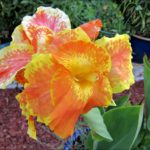 The canna lily plant is a perennial with tropical-like foliage and large flowers that resemble that of iris. Canna lilies are low maintenance and easy to grow, and both their flowers and foliage offer long-lasting color in the garden. Their rhyzome spreads easily. They bloom from mid-summer through fall in our Sunnyvale garden. Flower color may be red, orange or yellow. Depending on the variety, foliage color varies from green to maroon, bronze, and variegated types. We are growing ours in a large tall pot. It is the vertical thriller and the red lotus flowers are the spillers.
The canna lily plant is a perennial with tropical-like foliage and large flowers that resemble that of iris. Canna lilies are low maintenance and easy to grow, and both their flowers and foliage offer long-lasting color in the garden. Their rhyzome spreads easily. They bloom from mid-summer through fall in our Sunnyvale garden. Flower color may be red, orange or yellow. Depending on the variety, foliage color varies from green to maroon, bronze, and variegated types. We are growing ours in a large tall pot. It is the vertical thriller and the red lotus flowers are the spillers.
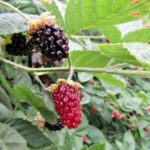 The Marionberry is a bright, glossy blackberry with medium to large fruit, somewhat longer than wide. Ninety percent of the world’s Marionberries are grown in Marion county. The Marionberry is a trailing vigorous grower, generally producing only a few long canes which grow up to 20 feet. The quality of the Marionberry is high, with flavor superior to the Boysenberry or Evergreen blackberries. Spring rains, and summers that are warm in the daytime and cool at night, provide just the right conditions to produce berries that are sweet and plump. The berry’s taste is distinctively sweet, yet has a mildly tart and lasting flavor.
The Marionberry is a bright, glossy blackberry with medium to large fruit, somewhat longer than wide. Ninety percent of the world’s Marionberries are grown in Marion county. The Marionberry is a trailing vigorous grower, generally producing only a few long canes which grow up to 20 feet. The quality of the Marionberry is high, with flavor superior to the Boysenberry or Evergreen blackberries. Spring rains, and summers that are warm in the daytime and cool at night, provide just the right conditions to produce berries that are sweet and plump. The berry’s taste is distinctively sweet, yet has a mildly tart and lasting flavor.
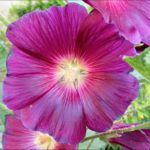 This is our first year growing hollyhocks (Alcea rosea) in our Sunnvyale garden. The flower stalks on hollyhocks can reach heights of 9 feet tall! We are growing outs in a large pot so they are even taller. We are growing them with hymenocallis which will flower in July. The hollyhock tower above a garden, adding a lovely vertical element to your yard. During their flowering season the plant has the 3 phases of the flowers in a vertical timeline: distinctive 5 sided sepals on the flower buds; the dazzling large flowers with a prominent anther that fallws off after pollination; and finally the flattened globes of the hollyhock hips.
This is our first year growing hollyhocks (Alcea rosea) in our Sunnvyale garden. The flower stalks on hollyhocks can reach heights of 9 feet tall! We are growing outs in a large pot so they are even taller. We are growing them with hymenocallis which will flower in July. The hollyhock tower above a garden, adding a lovely vertical element to your yard. During their flowering season the plant has the 3 phases of the flowers in a vertical timeline: distinctive 5 sided sepals on the flower buds; the dazzling large flowers with a prominent anther that fallws off after pollination; and finally the flattened globes of the hollyhock hips.
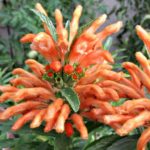 Leonotis leonurus, also known as lion’s tail and wild dagga, is a plant species in the Lamiaceae (mint) family. A broadleaf evergreen large shrub native to southern Africa, where it is very common. It is known for its medicinal and mild psychoactive properties. The main psychoactive component of Leonotis leonurus is leonurine. The shrub grows 3 to 6 ft tall by 1.5 to 3.5 feet wide. The medium-dark green 2–4 inches (5.1–10.2 cm) long leaves are aromatic when crushed. The plant has tubular orange flowers in tiered whorls, typical to the mint family, that encircle the square stems. Lion’s Tail is easy to grow in Sunnyvale (Zone 9). Our plant is 3 years old. It is drought-tolerant.
Leonotis leonurus, also known as lion’s tail and wild dagga, is a plant species in the Lamiaceae (mint) family. A broadleaf evergreen large shrub native to southern Africa, where it is very common. It is known for its medicinal and mild psychoactive properties. The main psychoactive component of Leonotis leonurus is leonurine. The shrub grows 3 to 6 ft tall by 1.5 to 3.5 feet wide. The medium-dark green 2–4 inches (5.1–10.2 cm) long leaves are aromatic when crushed. The plant has tubular orange flowers in tiered whorls, typical to the mint family, that encircle the square stems. Lion’s Tail is easy to grow in Sunnyvale (Zone 9). Our plant is 3 years old. It is drought-tolerant.
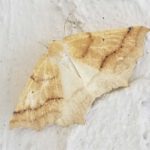 A moth.
A moth.
